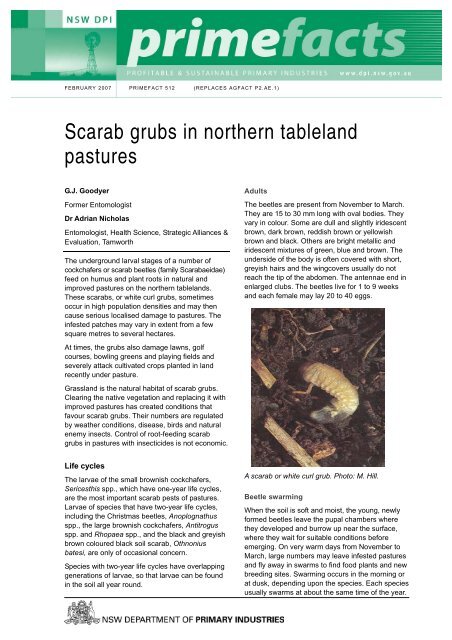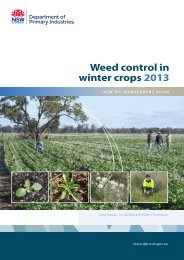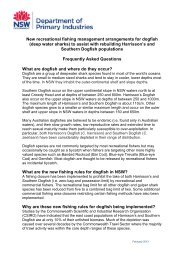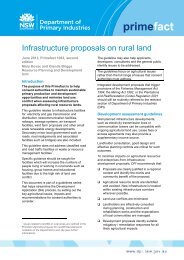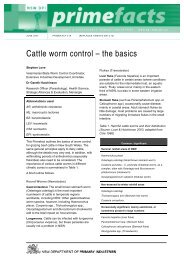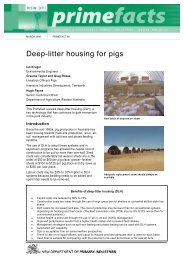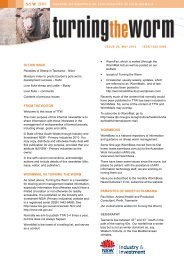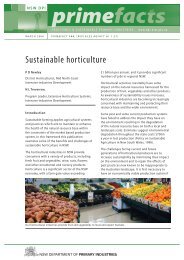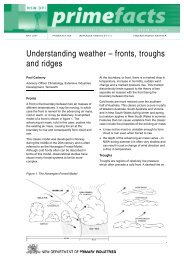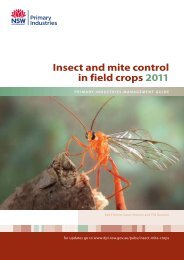Scarab grubs in northern tableland pastures - NSW Department of ...
Scarab grubs in northern tableland pastures - NSW Department of ...
Scarab grubs in northern tableland pastures - NSW Department of ...
You also want an ePaper? Increase the reach of your titles
YUMPU automatically turns print PDFs into web optimized ePapers that Google loves.
FEBRUARY 2007 PRIMEFACT 512 (REPLACES AGFACT P2.AE.1)<br />
<strong>Scarab</strong> <strong>grubs</strong> <strong>in</strong> <strong>northern</strong> <strong>tableland</strong><br />
<strong>pastures</strong><br />
G.J. Goodyer<br />
Former Entomologist<br />
Dr Adrian Nicholas<br />
Entomologist, Health Science, Strategic Alliances &<br />
Evaluation, Tamworth<br />
The underground larval stages <strong>of</strong> a number <strong>of</strong><br />
cockchafers or scarab beetles (family <strong>Scarab</strong>aeidae)<br />
feed on humus and plant roots <strong>in</strong> natural and<br />
improved <strong>pastures</strong> on the <strong>northern</strong> <strong>tableland</strong>s.<br />
These scarabs, or white curl <strong>grubs</strong>, sometimes<br />
occur <strong>in</strong> high population densities and may then<br />
cause serious localised damage to <strong>pastures</strong>. The<br />
<strong>in</strong>fested patches may vary <strong>in</strong> extent from a few<br />
square metres to several hectares.<br />
At times, the <strong>grubs</strong> also damage lawns, golf<br />
courses, bowl<strong>in</strong>g greens and play<strong>in</strong>g fields and<br />
severely attack cultivated crops planted <strong>in</strong> land<br />
recently under pasture.<br />
Grassland is the natural habitat <strong>of</strong> scarab <strong>grubs</strong>.<br />
Clear<strong>in</strong>g the native vegetation and replac<strong>in</strong>g it with<br />
improved <strong>pastures</strong> has created conditions that<br />
favour scarab <strong>grubs</strong>. Their numbers are regulated<br />
by weather conditions, disease, birds and natural<br />
enemy <strong>in</strong>sects. Control <strong>of</strong> root-feed<strong>in</strong>g scarab<br />
<strong>grubs</strong> <strong>in</strong> <strong>pastures</strong> with <strong>in</strong>secticides is not economic.<br />
Adults<br />
The beetles are present from November to March.<br />
They are 15 to 30 mm long with oval bodies. They<br />
vary <strong>in</strong> colour. Some are dull and slightly iridescent<br />
brown, dark brown, reddish brown or yellowish<br />
brown and black. Others are bright metallic and<br />
iridescent mixtures <strong>of</strong> green, blue and brown. The<br />
underside <strong>of</strong> the body is <strong>of</strong>ten covered with short,<br />
greyish hairs and the w<strong>in</strong>gcovers usually do not<br />
reach the tip <strong>of</strong> the abdomen. The antennae end <strong>in</strong><br />
enlarged clubs. The beetles live for 1 to 9 weeks<br />
and each female may lay 20 to 40 eggs.<br />
Life cycles<br />
The larvae <strong>of</strong> the small brownish cockchafers,<br />
Sericesthis spp., which have one-year life cycles,<br />
are the most important scarab pests <strong>of</strong> <strong>pastures</strong>.<br />
Larvae <strong>of</strong> species that have two-year life cycles,<br />
<strong>in</strong>clud<strong>in</strong>g the Christmas beetles, Anoplognathus<br />
spp., the large brownish cockchafers, Antitrogus<br />
spp. and Rhopaea spp., and the black and greyish<br />
brown coloured black soil scarab, Othnonius<br />
batesi, are only <strong>of</strong> occasional concern.<br />
Species with two-year life cycles have overlapp<strong>in</strong>g<br />
generations <strong>of</strong> larvae, so that larvae can be found<br />
<strong>in</strong> the soil all year round.<br />
A scarab or white curl grub. Photo: M. Hill.<br />
Beetle swarm<strong>in</strong>g<br />
When the soil is s<strong>of</strong>t and moist, the young, newly<br />
formed beetles leave the pupal chambers where<br />
they developed and burrow up near the surface,<br />
where they wait for suitable conditions before<br />
emerg<strong>in</strong>g. On very warm days from November to<br />
March, large numbers may leave <strong>in</strong>fested <strong>pastures</strong><br />
and fly away <strong>in</strong> swarms to f<strong>in</strong>d food plants and new<br />
breed<strong>in</strong>g sites. Swarm<strong>in</strong>g occurs <strong>in</strong> the morn<strong>in</strong>g or<br />
at dusk, depend<strong>in</strong>g upon the species. Each species<br />
usually swarms at about the same time <strong>of</strong> the year.
Swarm<strong>in</strong>g beetles are sometimes attracted to<br />
lights.<br />
The period and <strong>in</strong>tensity <strong>of</strong> beetle activity vary from<br />
year to year, depend<strong>in</strong>g upon the weather. If late<br />
spr<strong>in</strong>g and summer are very dry the newly formed<br />
beetles cannot leave the pupal chambers and will<br />
die there. After thunderstorms there may be mass<br />
emergences <strong>of</strong> beetles over a wide area.<br />
females <strong>of</strong> at least one <strong>of</strong> these species (the<br />
pru<strong>in</strong>ose scarab) may also mate and lay some<br />
eggs where they emerged before fly<strong>in</strong>g to eucalypt<br />
trees. Other beetles, <strong>in</strong>clud<strong>in</strong>g the <strong>tableland</strong><br />
pasture scarab, Antitrogus morbillosus, black soil<br />
scarab, Othnonius batesi, and the pasture white<br />
<strong>grubs</strong>, Rhopaea spp., do not feed, but may make<br />
short dispersal flights before mat<strong>in</strong>g.<br />
Pru<strong>in</strong>ose scarab, Sericesthis gem<strong>in</strong>ata. Length 11 to<br />
16 mm. Photo: M. Hill.<br />
Antitrogus sp., one <strong>of</strong> the large brownish cockchafers.<br />
Length 18 to 26 mm. Photo: M. Hill.<br />
Dusky pasture scarab, Sericesthis nigrol<strong>in</strong>eata.<br />
Length 10 to 13 mm, dark reddish brown colour,<br />
narrow blackish longitud<strong>in</strong>al l<strong>in</strong>es on the w<strong>in</strong>g covers.<br />
Photo: M. Hill.<br />
Adult pasture white grub, Rhopaea sp. Length 20 to<br />
30 mm. Photo: M. Hill.<br />
A Christmas beetle (the opal<strong>in</strong>e cockchafer,<br />
Anoplognathus porosus). Length 17 to 25 mm.<br />
Photo: S. J. Davidson.<br />
Some beetles, <strong>in</strong>clud<strong>in</strong>g the pru<strong>in</strong>ose scarab,<br />
Sericesthis gem<strong>in</strong>ata, the dusky pasture scarab, S.<br />
nigrol<strong>in</strong>eata, and the Christmas beetles,<br />
Anoplognathus spp., fly to eucalypts and other<br />
trees to feed and mate before return<strong>in</strong>g to the soil,<br />
where the females lay eggs. However, adult<br />
Beetles that fly to trees may feed and mate for<br />
several consecutive nights after swarm<strong>in</strong>g. Very<br />
heavily <strong>in</strong>fested trees can be severely defoliated.<br />
Repeated heavy defoliations by a complex <strong>of</strong> leafeat<strong>in</strong>g<br />
<strong>in</strong>sects, <strong>in</strong>clud<strong>in</strong>g the scarab beetles, are<br />
contribut<strong>in</strong>g to the decl<strong>in</strong>e and death <strong>of</strong> eucalypt<br />
trees on the <strong>northern</strong> <strong>tableland</strong>s. Isolated trees and<br />
small stands <strong>of</strong> trees surrounded by pasture are<br />
much more susceptible to attack by scarab beetles<br />
than trees <strong>in</strong> urban areas.<br />
Dur<strong>in</strong>g the day the dull-coloured Sericesthis spp.<br />
beetles hide under litter beneath the trees or <strong>in</strong> the<br />
soil <strong>of</strong> adjacent grassland. However, the brightly<br />
PRIMEFACT 512, SCARAB GRUBS IN NORTHERN TABLELAND PASTURES 2
coloured Anoplognathus spp. beetles rema<strong>in</strong> on<br />
the trees throughout the swarm<strong>in</strong>g period.<br />
and if conditions are very dry they favour moister,<br />
lower areas <strong>of</strong> <strong>pastures</strong> for egg lay<strong>in</strong>g.<br />
Eggs are generally laid 2 to 13 cm below the soil<br />
surface, either s<strong>in</strong>gly or <strong>in</strong> clusters and usually <strong>in</strong><br />
cells or cavities that the female makes <strong>in</strong> the earth.<br />
Newly laid eggs are white, oval and 1.5 to 5 mm<br />
long. They hatch after about 2 to 4 weeks.<br />
Larvae<br />
There are three larval stages. The larvae usually<br />
take about 10 months or about 21 months to reach<br />
maturity, depend<strong>in</strong>g on whether the species has a<br />
one-year or a two-year life cycle.<br />
The blacksoil scarab, Othnonius batesi. Colour black<br />
and greyish brown. Length 14 to 17 mm<br />
Illustration: A. Westcott.<br />
The beetles do not migrate to any extent. Those<br />
species that fly to trees and mate rarely travel more<br />
than 1 to 2 km from where they emerge and may<br />
re<strong>in</strong>fest the pasture where they developed as<br />
larvae. The non-feed<strong>in</strong>g species seldom move far<br />
from the emergence sites and normally stay <strong>in</strong> the<br />
same paddock.<br />
Newly hatched first stage larvae are 2 to 7 mm long<br />
with white bodies and brown or yellowish brown<br />
heads. If the soil is s<strong>of</strong>t and moist they make their<br />
way upward and feed on decay<strong>in</strong>g organic matter<br />
near the surface. The first stage larvae normally<br />
<strong>in</strong>gest large quantities <strong>of</strong> soil and decay<strong>in</strong>g organic<br />
matter. If there are large numbers <strong>of</strong> them they may<br />
also attack the roots <strong>of</strong> pasture plants. They<br />
develop to second stage larvae, which can feed<br />
extensively on plant roots as well as organic<br />
matter.<br />
Third stage larva <strong>of</strong> a pasture white grub,<br />
Length up to 60 mm. Photo: M. Hill.<br />
Rhopaea sp.<br />
A third stage scarab larva.<br />
Egg lay<strong>in</strong>g<br />
The beetles prefer grass-dom<strong>in</strong>ant <strong>pastures</strong> for egg<br />
lay<strong>in</strong>g and avoid areas <strong>of</strong> bare soil and legume<br />
dom<strong>in</strong>ant <strong>pastures</strong>. Soil moisture also <strong>in</strong>fluences<br />
egg lay<strong>in</strong>g. The females do not like dry or wet soils,<br />
Fully grown third stage larvae are white or creamywhite,<br />
s<strong>of</strong>t-bodied <strong>grubs</strong> 20 to 60 mm long and 5 to<br />
10 mm wide. When rest<strong>in</strong>g they are C-shaped.<br />
They have hard, brown, yellowish brown or reddish<br />
brown head capsules, strong bit<strong>in</strong>g mouthparts and<br />
three pairs <strong>of</strong> legs. The enlarged rear end<br />
commonly has a dark grey t<strong>in</strong>ge caused by faecal<br />
matter <strong>in</strong> the h<strong>in</strong>d gut show<strong>in</strong>g through. Third stage<br />
larvae take about 7 months or about 14 months to<br />
complete development, depend<strong>in</strong>g upon whether<br />
the species has a one-year or a two-year life cycle.<br />
Most damage is caused by the third stage larvae.<br />
They cut <strong>of</strong>f plant roots and feed on organic matter.<br />
When there are many <strong>of</strong> them they can be very<br />
destructive.<br />
PRIMEFACT 512, SCARAB GRUBS IN NORTHERN TABLELAND PASTURES 3
Most larvae <strong>of</strong> the species with a one-year life<br />
cycle develop to the third stage by mid to late<br />
autumn, about 3 months after hatch<strong>in</strong>g.<br />
Development cont<strong>in</strong>ues at a reduced rate dur<strong>in</strong>g<br />
w<strong>in</strong>ter and larval feed<strong>in</strong>g <strong>in</strong>tensifies <strong>in</strong> spr<strong>in</strong>g. The<br />
larvae stop feed<strong>in</strong>g and become prepupae by mid<br />
to late spr<strong>in</strong>g.<br />
the soil surface. Larvae are <strong>of</strong>ten present<br />
throughout the pasture <strong>in</strong> limited numbers but may<br />
be very numerous <strong>in</strong> scattered patches vary<strong>in</strong>g <strong>in</strong><br />
extent from a few square metres to several<br />
hectares. Adjacent <strong>pastures</strong> can differ greatly <strong>in</strong><br />
degree <strong>of</strong> <strong>in</strong>festation.<br />
The species with a two-year life cycle spend the<br />
first w<strong>in</strong>ter as second stage larvae. They develop<br />
<strong>in</strong>to third stage larvae <strong>in</strong> mid to late spr<strong>in</strong>g, about 8<br />
months after hatch<strong>in</strong>g.<br />
Larvae feed dur<strong>in</strong>g late spr<strong>in</strong>g, summer and<br />
autumn and then rema<strong>in</strong> relatively <strong>in</strong>active dur<strong>in</strong>g<br />
the second w<strong>in</strong>ter. They resume feed<strong>in</strong>g <strong>in</strong> the<br />
follow<strong>in</strong>g spr<strong>in</strong>g and become prepupae by late<br />
spr<strong>in</strong>g or early summer.<br />
A scarab pupa <strong>in</strong> a chamber <strong>in</strong> the soil. Photo: M. Hill.<br />
Prepupae and pupae<br />
When fully fed, the third stage larva makes an oval<br />
chamber, <strong>in</strong> which it will pupate, 2 to 25 cm deep <strong>in</strong><br />
the soil. The contents <strong>of</strong> the h<strong>in</strong>d gut are voided<br />
and the larva becomes a prepupa. Dur<strong>in</strong>g this time<br />
the curved, white or creamy white body becomes<br />
straighter and then shrivels, leav<strong>in</strong>g the rear end<br />
wr<strong>in</strong>kled and upturned. After 2 to 3 weeks the<br />
prepupae transform to pupae, which are pale<br />
yellow or yellow-brown and 15 to 35 mm long. After<br />
3 to 6 weeks the pupae have developed <strong>in</strong>to adult<br />
beetles.<br />
They stay <strong>in</strong> the pupal chambers until conditions<br />
become favourable for emergence.<br />
<strong>Scarab</strong> larva killed by a fungus, Cordyceps sp. The<br />
fungus then grows upwards to the soil surface.<br />
Photo: M. Hill.<br />
A scarab prepupa. Dur<strong>in</strong>g this period the body<br />
becomes paler, straighter, th<strong>in</strong>ner and more wr<strong>in</strong>kled.<br />
Photo: M. Hill.<br />
Damage<br />
The extent <strong>of</strong> damage to <strong>pastures</strong> by scarab <strong>grubs</strong><br />
varies with the <strong>in</strong>tensity <strong>of</strong> <strong>in</strong>festation, the seasonal<br />
conditions and graz<strong>in</strong>g management. It is usually<br />
most serious where the soil is shallow and plant<br />
growth is restricted by dryness and overgraz<strong>in</strong>g.<br />
Damage is worsened when drought and overstock<strong>in</strong>g<br />
reduce the plant’s capacity to replace severed<br />
roots.<br />
The <strong>grubs</strong> usually feed <strong>in</strong> the warmer months only,<br />
but may cont<strong>in</strong>ue throughout the year if the w<strong>in</strong>ter<br />
is mild. Dur<strong>in</strong>g warm weather <strong>in</strong> spr<strong>in</strong>g, summer<br />
and autumn, most larvae feed with<strong>in</strong> 1 to 2 cm <strong>of</strong><br />
Where the larval population is dense, all the plant<br />
roots may be cut <strong>of</strong>f. The soil underneath is loose<br />
and spongy due to the movement <strong>of</strong> the larvae and<br />
their <strong>in</strong>gestion <strong>of</strong> soil. Graz<strong>in</strong>g animals may uproot<br />
damaged pasture, and birds search<strong>in</strong>g for the<br />
larvae sometimes tear out large areas.<br />
Localised patches <strong>in</strong> <strong>pastures</strong> can be completely<br />
destroyed by the comb<strong>in</strong>ed effects <strong>of</strong> scarab grub<br />
attack, drought, overgraz<strong>in</strong>g and dislodg<strong>in</strong>g <strong>of</strong><br />
damaged plants, but this is uncommon. Established<br />
<strong>pastures</strong> are rarely harmed severely by one<br />
season’s <strong>in</strong>festation by white curl <strong>grubs</strong>. If there is<br />
no drought or overstock<strong>in</strong>g, damage to <strong>pastures</strong><br />
will usually not become serious until the third or<br />
fourth season after the <strong>in</strong>itial attack.<br />
Population regulation<br />
<strong>Scarab</strong> grub populations are naturally regulated by<br />
adverse weather conditions, disease, parasitism by<br />
<strong>in</strong>sects and predation by birds and <strong>in</strong>sects. Dur<strong>in</strong>g<br />
PRIMEFACT 512, SCARAB GRUBS IN NORTHERN TABLELAND PASTURES 4
and after seasons when adverse weather conditions<br />
suppress grub populations, the predators, parasites<br />
and diseases may help to ma<strong>in</strong>ta<strong>in</strong> them at nondamag<strong>in</strong>g<br />
levels. However, when widespread and<br />
severe scarab grub outbreaks occur, only the ma<strong>in</strong><br />
controll<strong>in</strong>g factor – the weather – can restore the<br />
natural balance.<br />
Insectivorous birds and parasitic wasps are the<br />
most useful natural enemies. The other <strong>in</strong>sect<br />
enemies are usually less important. However,<br />
large-scale land clear<strong>in</strong>g on the <strong>northern</strong> <strong>tableland</strong>s<br />
has destroyed many nest<strong>in</strong>g and roost<strong>in</strong>g sites <strong>of</strong><br />
non-migratory, <strong>in</strong>sectivorous birds and has reduced<br />
food sources for parasitic wasps. To improve<br />
biological control, exist<strong>in</strong>g on-farm native vegetation<br />
should be preserved, and more breed<strong>in</strong>g habitats<br />
for these birds (particularly the Australian magpie)<br />
and parasitic <strong>in</strong>sects should be created.<br />
Weather<br />
If conditions <strong>in</strong> spr<strong>in</strong>g and summer are very dry,<br />
many newly formed beetles die <strong>in</strong> the soil. Beetles<br />
that survive and emerge do not live long and the<br />
females lay few eggs. If hot and dry conditions<br />
persist dur<strong>in</strong>g summer and autumn, many eggs die<br />
from desiccation, and many newly hatched larvae<br />
die <strong>in</strong> the cells or cavities where the eggs were laid.<br />
New larvae that do make their way upwards may<br />
die from heat stress.<br />
Protracted wet weather <strong>in</strong> autumn, w<strong>in</strong>ter and<br />
spr<strong>in</strong>g may cause many larvae and pupae to die<br />
from drown<strong>in</strong>g or disease. Cont<strong>in</strong>ued heavy ra<strong>in</strong>fall<br />
<strong>in</strong> summer may cause waterlogg<strong>in</strong>g <strong>of</strong> the soil, and<br />
kill many eggs and newly-hatched larvae.<br />
Diseases<br />
<strong>Scarab</strong> grub populations are sometimes reduced<br />
by fungal, bacterial, viral or protozoan diseases.<br />
Affected <strong>grubs</strong> are abnormally coloured and have<br />
symptoms such as gangrenous legs, convulsive<br />
movements or general paralysis.<br />
the <strong>grubs</strong> one at a time and seldom disturb the<br />
surface <strong>of</strong> affected <strong>pastures</strong>.<br />
Parasitic wasps<br />
<strong>Scarab</strong> <strong>grubs</strong> are parasitised by hairy flower wasps<br />
(family Scoliidae) and thynnids or flower wasps<br />
(family Tiphiidae). The wasps feed on the nectar <strong>of</strong><br />
some flowers and on honeydew secreted by<br />
suck<strong>in</strong>g <strong>in</strong>sects such as scales, aphids and<br />
leafhoppers. They are only found <strong>in</strong> areas where<br />
these sources <strong>of</strong> food are available.<br />
Adult scoliids are 15 to 30 mm long with w<strong>in</strong>gspans<br />
<strong>of</strong> 25 to 40 mm. They are usually black or blueblack<br />
and have yellow, reddish yellow, orangeyellow,<br />
white or red spots, or transverse bands, on<br />
the head and body. They are <strong>of</strong>ten thickly covered<br />
with hairs. Their w<strong>in</strong>gs are smoky or dark with<br />
metallic iridescence and the ve<strong>in</strong>s are absent or<br />
only fa<strong>in</strong>tly visible towards the w<strong>in</strong>g tips. Males are<br />
slender with large eyes and long, straight<br />
antennae, while the females are stout with small<br />
eyes and short, curled antennae.<br />
A female hairy flower wasp (family Scoliidae). These<br />
wasps are 15 to 30 mm long and usually have no<br />
ve<strong>in</strong>s at the w<strong>in</strong>gtips. Photo: M. Hill.<br />
Insectivorous birds<br />
White curl <strong>grubs</strong> <strong>in</strong> <strong>northern</strong> <strong>tableland</strong> <strong>pastures</strong> are<br />
preyed upon by a large number <strong>of</strong> <strong>in</strong>sectivorous<br />
birds. The most important are the straw-necked<br />
ibis, Threskiornis sp<strong>in</strong>icollis, and the Australian<br />
magpie, Gymnorh<strong>in</strong>a tibicen.<br />
The straw-necked ibis roosts near swamps, lakes<br />
and other wet areas and is not as widely distributed<br />
as the Australian magpie. Ibises usually uproot<br />
large sections <strong>of</strong> <strong>in</strong>fested pasture while feed<strong>in</strong>g on<br />
the <strong>grubs</strong> and so aggravate exist<strong>in</strong>g damage.<br />
The Australian magpie <strong>in</strong>habits open-timbered<br />
country and is also found <strong>in</strong> urban parks and<br />
gardens. These habitats co<strong>in</strong>cide with the pr<strong>in</strong>cipal<br />
habitats <strong>of</strong> scarab <strong>grubs</strong>. Magpies f<strong>in</strong>d and remove<br />
A male thynnid or flower wasp (family Tiphiidae).<br />
These wasps are 15 to 25 mm long. Photo: M. Hill<br />
Adult tiphiids (thynnids) are 15 to 25 mm long with<br />
w<strong>in</strong>gspans up to 40 mm. They are usually black,<br />
brown, reddish brown, orange-brown or reddish.<br />
They have dark brown, yellow or black spots or<br />
transverse bands on the head and body. The males<br />
are stout, with well developed legs, long, straight<br />
PRIMEFACT 512, SCARAB GRUBS IN NORTHERN TABLELAND PASTURES 5
antennae and smoky or reddish brown w<strong>in</strong>gs.<br />
Females are w<strong>in</strong>gless and antlike, with short,<br />
curled antennae and short, stout legs.<br />
Hairy flower wasp feed<strong>in</strong>g. Photo: S. J. Davidson.<br />
Wasp egg near the head <strong>of</strong> this scarab larva.<br />
Wasp larva feed<strong>in</strong>g on the scarab larva.<br />
Larva <strong>of</strong> a robber fly. Length 30 to 40 mm when<br />
fully fed. Illustration: A. Westcott.<br />
After hatch<strong>in</strong>g from the egg, the parasite larva<br />
feeds on the body <strong>of</strong> the scarab grub. When fully<br />
fed the larva pupates <strong>in</strong> a 20 to 35 mm long cigarshaped<br />
cocoon which is smooth, brown and very<br />
tough.<br />
Adult scoliid and thynnid wasps live for about 2<br />
months. There are one or more generations a year,<br />
depend<strong>in</strong>g upon the species. The wasps overw<strong>in</strong>ter<br />
as fully grown larvae, pupae or adults <strong>in</strong> cocoons <strong>in</strong><br />
the soil.<br />
Pupa alongside the rema<strong>in</strong>s <strong>of</strong> the scarab larva. Hairy<br />
flower wasp young feeds on third stage scarab larvae<br />
<strong>in</strong> cells <strong>in</strong> the ground.<br />
Photos: C. Haywood.<br />
On warm, sunny morn<strong>in</strong>gs <strong>in</strong> spr<strong>in</strong>g, summer and<br />
autumn, male scoliids and thynnids fly over scarab<br />
grub <strong>in</strong>fested <strong>pastures</strong>, search<strong>in</strong>g for female<br />
wasps. After mat<strong>in</strong>g, the female wasps burrow <strong>in</strong>to<br />
the soil to locate third stage <strong>grubs</strong> and paralyse<br />
them by st<strong>in</strong>g<strong>in</strong>g. Thynnid wasps lay an egg on<br />
each grub and then leave. Scoliids drag the <strong>grubs</strong><br />
deeper <strong>in</strong>to the ground, make earthen cells around<br />
them and then lay an egg on each grub.<br />
Predatory and parasitic flies<br />
The soil-dwell<strong>in</strong>g larvae <strong>of</strong> robber flies (family<br />
Asilidae) prey upon scarab <strong>grubs</strong>. Some adult<br />
robber flies also prey upon the adult beetles. Fully<br />
fed asilid larvae are 30 to 40 mm long with white or<br />
creamy white cyl<strong>in</strong>drical bodies and hook-shaped<br />
heads. Robber fly adults are 20 to 25 mm long with<br />
w<strong>in</strong>gspans <strong>of</strong> 30 to 40 mm. They have slender<br />
black or brownish bodies, long, bristly legs, a pair<br />
<strong>of</strong> clear or smoky w<strong>in</strong>gs and a bayonet-like beak.<br />
Adult beetles and scarab <strong>grubs</strong> are also parasitised<br />
by flies <strong>of</strong> the family Tach<strong>in</strong>idae. Eggs are laid<br />
PRIMEFACT 512, SCARAB GRUBS IN NORTHERN TABLELAND PASTURES 6
either <strong>in</strong> or on the beetle or <strong>in</strong> the soil and the<br />
parasite larva feeds on the body contents <strong>of</strong> the<br />
beetle or grub. Tach<strong>in</strong>id flies are 6 to 15 mm long<br />
with w<strong>in</strong>gspans <strong>of</strong> 10 to 25 mm. They have stout<br />
and <strong>of</strong>ten very bristly bodies rang<strong>in</strong>g from dull grey<br />
or brown to sh<strong>in</strong><strong>in</strong>g metallic mixtures <strong>of</strong> green,<br />
blue, red and black.<br />
vary <strong>in</strong> colour from black or brownish to green or<br />
purple. Many give <strong>of</strong>f a disagreeable odour when<br />
disturbed. The fully grown carabid larva is 10 to 25<br />
mm long, slender and semi-flattened, with a large<br />
dark head, three pairs <strong>of</strong> short legs and a prom<strong>in</strong>ent<br />
pair <strong>of</strong> sp<strong>in</strong>e-like, fleshy processes on the rear <strong>of</strong><br />
the body. The body is white, pale yellow or brown,<br />
<strong>of</strong>ten with dark plates.<br />
A robber fly. Length 20 to 25 mm. Photo: S.J.<br />
Davidson.<br />
Larva <strong>of</strong> a carabid beetle. Length 10 to 25 mm when<br />
fully fed. Illustration: A. Westcott.<br />
A tach<strong>in</strong>id fly. Tach<strong>in</strong>ids are 6 to 15 mm long. Photo:<br />
M. Hill.<br />
Two types <strong>of</strong> larvae <strong>of</strong> click beetles (family Elateridae).<br />
Elaterid larvae are 15 to 40 mm long when fully<br />
developed. Photos: S. J. Davidson. Left. S<strong>of</strong>t semiflattened<br />
larva. Right. Hard round larva.<br />
A carabid beetle. Carabids are 6 to 20 mm long.<br />
Photo: S. J. Davidson.<br />
Predatory beetles<br />
Adult and larval stages <strong>of</strong> carabid beetles or<br />
predatory ground beetles (family Carabidae) prey<br />
upon white curl <strong>grubs</strong>. These beetles, which hunt at<br />
night and hide by day, are 6 to 20 mm long with<br />
flattened, elongated bodies and long legs. They<br />
Larval stages <strong>of</strong> click beetles (family Elateridae)<br />
also prey upon white curl <strong>grubs</strong>. Fully grown<br />
elaterid larvae are 15 to 40 mm long and differ<br />
widely <strong>in</strong> form and colour. Some have s<strong>of</strong>t, semiflattened,<br />
smooth, yellow or creamy white bodies,<br />
darker wedge-shaped heads and forked, toothedged<br />
tails. Others have hard, round, smooth<br />
bodies which are yellow, brown, reddish brown or<br />
yellowish brown, and have flattened, rounded or<br />
conical tails and wedge-shaped heads.<br />
Controll<strong>in</strong>g scarab <strong>grubs</strong><br />
Cultivation, if feasible, can be used to suppress<br />
scarab grub populations. Several shallow cultivations<br />
with a f<strong>in</strong>e-toothed heavy harrow dur<strong>in</strong>g the warm<br />
PRIMEFACT 512, SCARAB GRUBS IN NORTHERN TABLELAND PASTURES 7
summer/autumn period will destroy many eggs and<br />
<strong>grubs</strong> through the comb<strong>in</strong>ed effects <strong>of</strong> mechanical<br />
<strong>in</strong>jury, desiccation and exposure to predation.<br />
Close graz<strong>in</strong>g <strong>of</strong> pasture dur<strong>in</strong>g late spr<strong>in</strong>g,<br />
summer and autumn will make eggs and <strong>grubs</strong> <strong>in</strong><br />
the topsoil more susceptible to desiccation and<br />
predation, but can encourage some other pasture<br />
<strong>in</strong>sect pest problems, such as w<strong>in</strong>gless grasshopper.<br />
Acknowledgments<br />
The author thanks, for discussion and review <strong>of</strong> this<br />
<strong>in</strong>formation, Mr A J Campbell, Entomologist,<br />
<strong>Department</strong> <strong>of</strong> Agriculture (now <strong>NSW</strong> DPI),<br />
Armidale and Dr R L Davidson, CSIRO Division <strong>of</strong><br />
Plant Industries, Armidale.<br />
Magpies are useful predators <strong>of</strong> scarab <strong>grubs</strong>. They<br />
need clumps <strong>of</strong> trees for successful nest<strong>in</strong>g. Photo: S.<br />
J. Davidson.<br />
Nectar-bear<strong>in</strong>g native plants provide food for adults <strong>of</strong><br />
natural enemy <strong>in</strong>sects that kill scarab <strong>grubs</strong>. Photo: R<br />
L. Davidson.<br />
Promot<strong>in</strong>g natural control agents<br />
Steps can be taken to encourage <strong>in</strong>sectivorous<br />
birds and parasitic <strong>in</strong>sects, particularly the wasps.<br />
You should provide suitable nest<strong>in</strong>g and roost<strong>in</strong>g<br />
sites for the birds and keep small fenced areas <strong>of</strong><br />
nectar- bear<strong>in</strong>g native plants (<strong>in</strong>clud<strong>in</strong>g eucalypts,<br />
tea-trees, rough-barked apple and blackthorn) near<br />
or <strong>in</strong> <strong>pastures</strong> as sources <strong>of</strong> food for the <strong>in</strong>sects.<br />
Keep a range <strong>of</strong> plant species <strong>in</strong> these areas at all<br />
times. Keep graz<strong>in</strong>g livestock out.<br />
© State <strong>of</strong> New South Wales<br />
through <strong>NSW</strong> <strong>Department</strong> <strong>of</strong> Primary Industries 2007<br />
ISSN 1832-6668<br />
Replaces Agfact P2.AE.1<br />
Check for updates <strong>of</strong> this Primefact at:<br />
www.dpi.nsw.gov.au/primefacts<br />
Disclaimer: The <strong>in</strong>formation conta<strong>in</strong>ed <strong>in</strong> this publication is<br />
based on knowledge and understand<strong>in</strong>g at the time <strong>of</strong> writ<strong>in</strong>g<br />
(February 2007). However, because <strong>of</strong> advances <strong>in</strong><br />
knowledge, users are rem<strong>in</strong>ded <strong>of</strong> the need to ensure that<br />
<strong>in</strong>formation upon which they rely is up to date and to check<br />
currency <strong>of</strong> the <strong>in</strong>formation with the appropriate <strong>of</strong>ficer <strong>of</strong><br />
New South Wales <strong>Department</strong> <strong>of</strong> Primary Industries or the<br />
user’s <strong>in</strong>dependent adviser.<br />
Job number 7428<br />
PRIMEFACT 512, SCARAB GRUBS IN NORTHERN TABLELAND PASTURES 8


